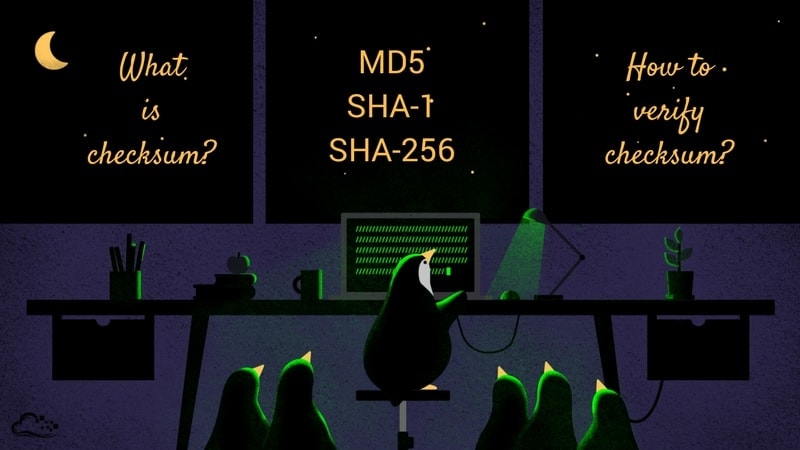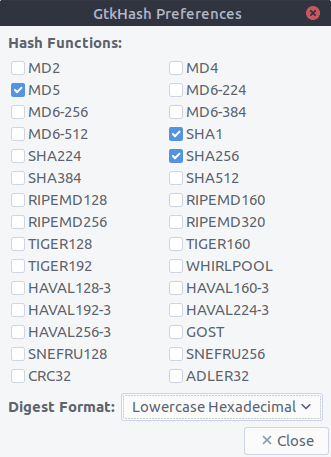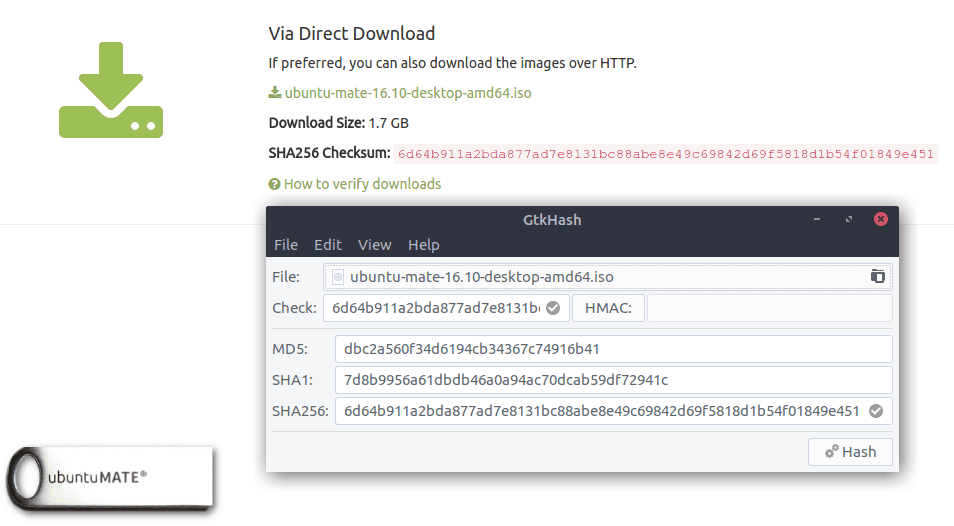- HowToSHA256SUM
- sha256
- sha256sum on Linux
- Check the iso file
- Manual method
- Semi-automatic method
- Success
- Check the CD
- Manual method
- Success?
- MD5SUM on Mac OS X
- digest(1) on Solaris
- SHA256SUM on Windows
- MD5SUM with «Checksums calculator»
- SHA256SUM on CD
- SHA256SUM of burnt media
- External Links
- How to Verify Checksum on Linux [Beginner Guide]
- How is a Checksum generated?
- Installing GtkHash on Ubuntu
- Using GtkHash
- Verify checksums via Linux command line
- Generating and Verifying SHA256 Checksum with sha256sum
- How accurately does this work?
HowToSHA256SUM
The program sha256sum is designed to verify data integrity using the SHA-256 (SHA-2 family with a digest length of 256 bits). SHA-256 hashes used properly can confirm both file integrity and authenticity. SHA-256 serves a similar purpose to a prior algorithm recommended by Ubuntu, MD5, but is less vulnerable to attack.
Comparing hashes makes it possible to detect changes in files that would cause errors. The possibility of changes (errors) is proportional to the size of the file; the possibility of errors increase as the file becomes larger. It is a very good idea to run an SHA-256 hash comparison check when you have a file like an operating system install CD that has to be 100% correct.
In terms of security, cryptographic hashes such as SHA-256 allow for authentication of data obtained from insecure mirrors. The SHA-256 hash must be signed or come from a secure source (such as a HTTPS page or a GPG-signed file) of an organization you trust. See the SHA-256 checksum file for the release you’re using under http://releases.ubuntu.com, such as http://cdimage.ubuntu.com/daily-live/current/SHA256SUMS . You should verify this file using the PGP signature, SHA256SUMS.gpg (such as http://cdimage.ubuntu.com/daily-live/current/SHA256SUMS.gpg ) as described in VerifyIsoHowto.
sha256
sha256sum on Linux
Most Linux distributions come with the sha256sum utility (on Ubuntu it is part of the coreutils package). We are going to use the Ubuntu 9.10 LiveDVD for the following example:
Check the iso file
Ubuntu distributes the SHA-256 checksum hashes in a file called SHA256SUMS in the same directory listing as the download page for your release http://releases.ubuntu.com.
Manual method
sha256sum ubuntu-9.10-dvd-i386.iso
c01b39c7a35ccc3b081a3e83d2c71fa9a767ebfeb45c69f08e17dfe3ef375a7b *ubuntu-9.10-dvd-i386.iso
Compare the hash (the alphanumeric string on left) that your machine calculated with the corresponding hash in the SHA256SUMS file.
When both hashes match exactly then the downloaded file is almost certainly intact. If the hashes do not match, then there was a problem with either the download or a problem with the server. You should download the file again from either the same mirror, or from a different mirror if you suspect a server error. If you continuously receive an erroneous file from a server, please be kind and notify the web-master of that mirror so they can investigate the issue.
Semi-automatic method
cd download_directory sha256sum -c SHA256SUMS 2>&1 | grep OK
If the OK for your file appears, that indicates the hash matches.
Success
Once you have verified the sha256 hash, go ahead and burn the CD. You may want to refer to the BurningIsoHowto page.
Check the CD
So far so good, you have downloaded an iso and verified its integrity. When you boot from the CD you will be given the option to test its integrity. Great, but if the CD is corrupt then you have already wasted time rebooting. You can check the integrity of the CD without rebooting as follows.
Manual method
Check the calculated hash against UbuntuHashes as shown for the iso file above. Depending on your system, you may need to change cdrom to cdrom0 (or even cdrom1 if you have two CD drives).
Success?
Congratulations, you now have a verified Ubuntu CD. Go ahead and use it (or play frisbee with it if you want).
MD5SUM on Mac OS X
This should be updated by someone with access to a Mac.
There are three methods of using md5sumsum on an OS X machine.
Method 1 — The easiest (if MD5 is available) is using the Disk Utility program (Applications > Utilities, or by choosing «Utilities» from the Finder’s «Go» menu). Open Disk Utility and wait for it to gather information about your disks. Go to the directory where you downloaded the Ubuntu disk image, and drag it to Disk Utility’s dock icon (displays on the left-hand side of Disk Utility, underneath your physical drives). Select the iso file. Go to the «Images» menu and select Checksum > MD5. Be sure to choose «MD5» and NOT «MD5 image checksum» or «CRC-32 image checksum», as they are not the same and will give you different results.
Method 2 — If MD5 is not available in the Images > Checksum menu, open a terminal window (Applications > Utilities > Terminal.app). Type «md5», type a space, drag the iso file into the terminal window (appends command with iso file path), and press Enter. The command line returns the hash number.
Method 3 — You can use the Terminal.app and follow the instructions for SHA256SUM on Linux, except use the command «openssl md5» instead of «sha256sum».
Each method returns a hash number. Compare the hash number with the corresponding hash on the UbuntuHashes page. When both hashes match exactly, then the downloaded file is almost certainly intact.
If the hashes do not match, then there was a problem with either the download or a problem with the server. You should download the file again from either the same mirror, or from a different mirror if you suspect a server error. If you continuously receive an erroneous file from a server, please notify the web-master of that mirror so they can investigate the issue.
digest(1) on Solaris
$ digest -a sha256 ubuntu-9.10-dvd-i386.iso c01b39c7a35ccc3b081a3e83d2c71fa9a767ebfeb45c69f08e17dfe3ef375a7b
SHA256SUM on Windows
This section also needs to be updated. Is there a sha256sum.exe file distributed by a reliable source? Is there a good GUI?
Windows does not come with sha256sum. You must download one from another location, preferably one that you trust. There are command line utilities that work similarly to the Unix utility; one public domain version with source is available from Fourmilab, but the version available from Cygwin is probably easier to install and update, and Cygwin is also recommended and trusted as the source for many more Unixy utilities. Once installed, Cygwin’s sha256sum behaves exactly as described in SHA256SUM on Linux above.
- Download and install winSha256sum, a free and open source hash verification program.
- Right-click the ISO file.
- Click Send To, then winSha256sum.
- Wait for winSha256sum to load and finish the checksum (this may take a significant amount of time depending on your computer’s performance).
- Copy the corresponding hash from UbuntuHashes into the bottom text box.
- Click «Compare»
- A message box will say «MD5 Check Sums are the same» if the hashes are equal.
MD5SUM with «Checksums calculator»
«Checksums calculator” is an open source GUI application that has been developed to run on Windows, MacOS X and Linux operating systems on 32bit and 64bit architectures while is translated into 19 languages. It gives you the ability to calculate checksums of functions: md5, sha1, sha256, sha384 and sha512. It is very simple to use, after downloaded the zip file with the version that fits on your computer, doesn’t require any installation, just unzip it to any folder of your choice. Once you run it, select the file you want to calculate the checksum, then select the function and click the «Calculate» button. If you want to compare the result, in the field «Original checksum» give the checksum that you downloaded and click the «Compare» button. You can download the application here.
The program while is running under Windows 7 64bit.
The program while is running under Snow Leopard 10.6 32bit.
The program while is running under Ubuntu 10.04 64bit.
SHA256SUM on CD
I don’t know if there is now a sha256sum.txt file on the CD.
To see if your Ubuntu CD was corrupted when burned to the disk, see the CDIntegrityCheck page, or follow the instructions below.
First mount the CD, if not already mounted:
Then use the supplied sha256sum file on the CD:
Be patient, it takes some time. If the command outputs any errors, you’ll know that either the burn was bad or the .iso is corrupt. Please note that this method does not verify authenticity unless the hash of the iso file is compared to the hash at the secure UbuntuHashes page.
Finally, you can unmount the CD after leaving the folder:
SHA256SUM of burnt media
$ grep ubuntu-9.10-dvd-i386.iso SHA256SUMS | tee /proc/self/fd/2 | sha256sum --check - c01b39c7a35ccc3b081a3e83d2c71fa9a767ebfeb45c69f08e17dfe3ef375a7b *ubuntu-9.10-dvd-i386.iso ubuntu-9.10-dvd-i386.iso: OK
$ sha256sum /dev/cdrom c01b39c7a35ccc3b081a3e83d2c71fa9a767ebfeb45c69f08e17dfe3ef375a7b /dev/cdrom
where «/dev/cdrom» is typically a soft-link to your CD/DVD reader/burner. Note that the checksum matches.
External Links
HowToSHA256SUM (последним исправлял пользователь ip-84-203-58-58 2015-12-14 23:05:24)
The material on this wiki is available under a free license, see Copyright / License for details
You can contribute to this wiki, see Wiki Guide for details
How to Verify Checksum on Linux [Beginner Guide]
A checksum is a small-sized datum from a block of digital data for the purpose of detecting errors which may have been introduced during its transmission or storage.
So a checksum is a long string of data containing various letters and numbers. You’ll generally find them when downloading files from the web, e.g. Linux distribution images, software packages, etc.
The most common use of checksums is for checking if a downloaded file is corrupted.
For instance, the Ubuntu MATE download page includes an SHA-256 checksum for every image it makes available. So after you’ve downloaded an image, you can generate an SHA-256 checksum for it and verify that the checksum value matches the one listed on the site.
If it doesn’t, that means your downloaded image’s integrity is compromised (maybe it was corrupted during the download process). We will use an Ubuntu MATE “ubuntu-mate-16.10-desktop-amd64.iso” image file for this guide.
How is a Checksum generated?
Each checksum is generated by a checksum algorithm. Without going into the technical details let’s just say it takes a file as input and outputs the checksum value of that file. There are various algorithms for generating checksums. The most popular checksum algorithms are:
Let’s see how to verify a checksum on Linux.
Installing GtkHash on Ubuntu
To install GtkHash on your Ubuntu system, simply run the following command:
That’s it. Then select the checksum algorithms to use:
- Go to Edit >Preferences in the menu.
- Select the ones you’d like to use.
- Hit the Close button.
By default, MD5, SHA-1 and SHA256 are selected.
Using GtkHash
Using it is quite straight-forward.
- Select the file you want to check.
- Get the Checksum value from the website and put it in the Check box.
- Click the Hash button.
- This will generate the checksum values with the algorithms you selected.
- If any one of them matches with the Check box, it will show a small tick sign beside it.
Here’s an example showing GtkHash generating a checksum for the Ubuntu MATE iso image (ubuntu-mate-16.10-desktop-amd64.iso):
Verify checksums via Linux command line
Every Linux distribution comes with tools for various checksum algorithms. You can generate and verify checksums with them. The command-line checksum tools are the following:
- MD5 checksum tool is called md5sum
- SHA-1 checksum tool is called sha1sum
- SHA-256 checksum tool is called sha256sum
There are some more available, e.g. sha224sum, sha384sum, etc. All of them use similar command formats. Let’s see an example using sha256sum. We’ll use the same “ubuntu-mate-16.10-desktop-amd64.iso” image file that we used before.
Generating and Verifying SHA256 Checksum with sha256sum
First go to the directory where the .iso image is stored:
Now, to generate the SHA-256 checksum, enter the following command:
sha256sum ubuntu-mate-16.10-desktop-amd64.isoYou’ll see the SHA-256 checksum in your terminal window! Easy, isn’t it?
If the generated checksum matches the one provided on the Ubuntu MATE download page, that will mean no data was changed while you downloaded the file – in other words, your downloaded file is not corrupted.
The other tools mentioned work similarly.
How accurately does this work?
If you’re wondering how accurately these checksums detect corrupted files – if you delete or change even one character from any one of the text files inside the iso image, the checksum algorithm will generate a totally different value for that changed image. And that will definitely not match the checksum provided on the download page.
Do you checksum?
One of the suggested steps while installing Linux is to verify the checksum of your Linux ISO. Do you always follow this step or do you do it only when something goes wrong with the installation?
Was this guide helpful? If you have any questions, let us know! And if you need a similar guide for something else, reach out to us, we’re here to help.



